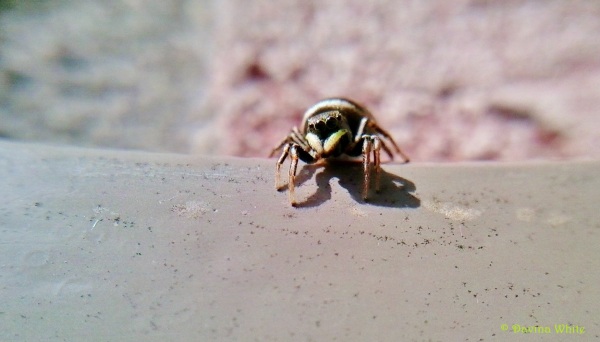No specific spider in the spotlight this sunday, but my brother came up with a great idea instead. He asked me to write a post on how to determine the species of spiders. I suppose more readers are wondering this, so here are a few tips for photographing and determining the species of spiders. Feel free to add suggestions or ask questions in the comments!

The first clue you can use to determine which spider species you’ve encountered is the environment you find the spider in. Have you seen it in a garden, park, forest or inside a building? A book or website on the most common spider species in your area might help. If you saw the spider in a common place during the day, chances are that they are described in a field guide. Knowing the environment you found the spider in will help in narrowing the search. The field guide will also tell you whether a spider is dangerous or not. I’m fortunate to live in the Netherlands where all native spiders are relatively harmless (a few might bite, but only when provoked and the bite won’t kill you). Spiders in other countries could be poisonous and even lethal, so keeping a safe distance is advised!
The next clue is its web (or lack thereof). Is it sitting on or near a web? If so, what type of web is it? There are variations, but usually webs fall under one of these categories:
- Spiral orb webs
- Sheet webs
- Funnel webs
- Tubular webs
- Tangle/cobwebs
Most spiders are classified based on the webs they build. For example the cross spider always builds a spiral orb web (thus belongs to the orb weavers family) and the labyrinth spider always builds a funnel-web (thus belongs to the funnel-web spider family). However, jumping spiders and running crab spiders never build webs. Look closer for additional characteristics of the web. Does it miss sectors or does it consists of additional parts? A warning though: not all web-building spiders are close to their webs 24/7. Especially males wander around during mating season.
Looks are also an important clue for determining the species. Check the overall shape of the spider. Is it mostly round? Stretched? Does it have conspicuous features? See if you can spot interesting markings on the head or abdomen of the spiders or if the legs differ in size and have markings. Is the spider hairy or smooth? If you can zoom in on the eyes, how are they arranged? All eyes on the front or some on the sides of the head? These features help a lot in your search, especially if you know the type of web the spider builds. For example, both the cross spider and the silver stretch spider build very similar looking spiral orb webs, but the cross spider is round and the silver stretch spider is elongated. In various spider families, the markings on head, abdomen or legs are distinctive for the species. Therefore when photographing a spider, it is good to take as many pictures from the different angles as you can. Of course there are some exceptions to this. Certain species may differ greatly in colour and some can even change their colour!
Last clue to look for is the behaviour of the spider. This can be difficult to observe, but I encourage you to follow the spiders you encounter. Has the spider a need for speed or does it hide away in a corner? Jumping spiders are usually curious spiders and will observe you in return. Come too close and it will attack you. I noticed that running crab spiders hide behind the leaf I saw them sitting on whenever I got too close. The same applies with web building. Does the spider build its web at night or during the day?

I hope these general clues help you when observing spiders. Do take a look at my previous posts for more characteristics specific for the particular species. Happy spider spying!






Indeed, Davina, this was a very interesting blog! Thanks for sharing!!
Difficult ! Ok , we know there are a lot you can recongnise easily like the common cross spider or the Nursery web spider ….. but for all those little ones you need problably to look closer at the genitals ( with binoculairs ) . My experience on “waarneming.nl” is the fact is very hard to get your guess validated ….. In that case my determination ends like indet. or spec. 🙂 But as you already suggested : take pictures from the top , front , side and the bottom side when possible . Another little problem : a lot of spiders have complete different looks when male or femal 🙂